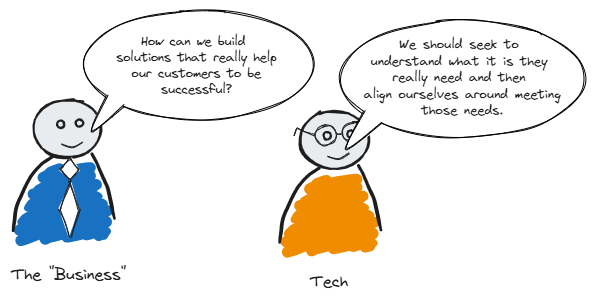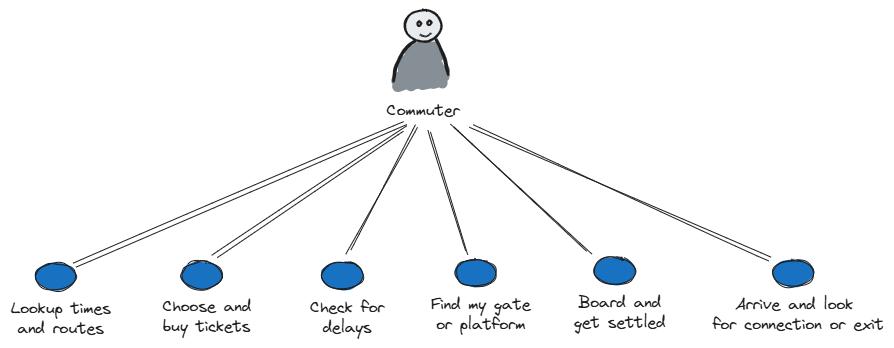Step 3: Defining User Needs

Why defining User Needs matters
After identifying your users, the next critical step is defining their needs. Clearly articulated user needs ensure your organization focuses on delivering outcomes that matter. This step bridges the gap between understanding your users and aligning organizational capabilities to meet their expectations.
If you are in a siloed organisation with separate Product and Engineering teams, you will probably find that the Product team is currently responsible for defining the user needs, and the Engineering team is responsible for delivering the solutions. This is the gap that User Needs Mapping aims to bridge.
If you are lucky enough to already be in a cross-functional stream-aligned team, then having the capability to define user needs is an essential skill for delivering solutions that matter.
What is a User Need?
A user need can be summarised as:
The underlying goal or outcome a person wants to achieve when they seek out a product or service i.e. the reason they look for a particular solution.
Troubles defining User Needs

Sometimes, it can feel difficult to pin down what “user needs” actually are because it requires identifying motivations or pain points that aren’t always obvious on the surface. A more tangible starting point can be the user journey, which maps out the steps and experiences people go through as they interact with a product or service.
This journey view helps highlight where challenges crop up and where people get “stuck,” making it clearer how to address their underlying needs. After sketching out the journey, teams can come back to flesh out the specific user needs discovered along the way, ensuring they don’t miss the contextual details that truly define what people want and why they want it.
Spotting the User Needs in a journey

Starting with the user journey is a good way to get started and is excellent for identifying how you currently support your users with existing systems. However, it’s important to remember that the user journey is not the same as the user’s needs. Taking time to understand the underlying needs can start to uncover opportunities to improve the user’s experience and the systems you have in place.
Reach out to people in your organization in the User Experience (UX), User Research or Product team to help you understand needs your organization is trying to deliver solutions for. They probably have a good understanding of the journey your users are taking and what they are trying to achieve. Any User Needs Mapping workshop should include people from across the organization to bring diverse insights to the conversation.
Key Actions
Here are some key actions to take when defining user needs:
- Focus on outcomes: Frame needs based on what users want to achieve, not the solutions they might use.
- Use verbs: Describe user needs in terms of actions (e.g., “Ensure I arrive at my destination on time.” or “Understand how to use the product effectively”).
- Avoid solutions: Ensure needs describe problems or goals, not specific implementations.
If you’d like to more about user needs from Simon Wardleys perspective, you can read his online book Chatper 6: Getting started
I would also recommend looking at the Jobs to be Done framework, which is a great way to understand the underlying needs of your users (although it can get quite “involved”).
Guidelines for writing User Needs
Writing user needs is a bit of an art. Here are some guidelines to help you get started:
- Be specific: Write needs that clearly define the user’s goal or challenge.
- Validate with users: Check if the need resonates with the actual user group.
- Describe the problem: Focus on the issue to solve, not the tool or system to solve it.
Practical Examples
The following examples show some poorly defined needs versus well-defined needs.
| Poorly Defined Need | Well-Defined Need |
|---|---|
| “Add a search feature.” | “Find products quickly and easily.” |
| “Build a reporting dashboard.” | “Track progress and identify trends.” |
| “Create a ticketing API.” | “Generate tickets automatically.” |
Language matters. It’s important to use language that is clear, concise and not solution or feature focused.
Exercise
Write three user needs for one of the user groups you identified in Step 2. Use these prompts to guide your thinking:
- What is the user trying to achieve?
- Would the user recognize this as their need?
- Does this describe a problem rather than a solution?
Do you really understand what a User Need is?
Why not test yourself with our mini-quiz? It should only take a few minutes and will help you understand if you really understand what a User Need is.
Take our ‘Real or Not’: A User Needs Challenge
What’s Next?
With well-defined user needs, the next step is to map the organizational capabilities required to meet them.
Proceed to Step 4: Mapping Capabilities
Need help to get things moving?
If you are looking for help to get started, please do not hesitate to reach out.
Reach out to us